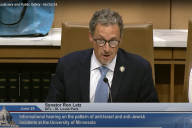You have /5 articles left.
Sign up for a free account or log in.
The storm surge picked up the pink casino and dropped it in a parking lot. It was built on a barge the size of an office building and came to rest against the eight-story garage of a different casino. Before Katrina, casinos had to be “offshore” per Mississippi gambling regulations, which meant the non-seagoing barges were tethered to docks. Now all of them have to be land-based.
Next to the parking lot, past a chain link fence to keep casino visitors off the crumbling quay wall, there’s a basin with several acres of water. Across the mouth of the basin there’s an ugly breakwater with only a narrow passage for small boats. A couple are fishing off a motorboat in the basin, and two other motorized craft and an engineless barge are tied up at a distance. Boats coming in have to run along a large peninsula of raw dirt, where the dust billows every time one of the massive clamshell diggers working on it takes another bite, and when trucks hauling dirt drive out to the end and back. A dredging barge helps the effort to extend the tip of the peninsula a little further into the Gulf.
The company that owned the casino barge trashed it and (presumably with insurance money) built a permanent casino a few hundred yards away across the lot. Its hotel is on the beach; a skybridge crosses the highway to the casi
Just to the east, at 30th Avenue and US 90, is the Chiquita shipping yard, which is full of disengaged semi trailers, shipping containers, truck cabs, and a warehouse. A building marked Mississippi Power is across the highway. East of the Chiquita facility is the Dole container terminal, the Mississippi State Port (East and West docks), a Coast Guard building, and a Ship Ferry. Lots of new construction, but also scraped-bare lots and empty foundations that the storm washed out. Fences and barbed wire and warning signs.
East of that, Ship Island Marina. (A reminder today of how bright it is on the water, and it’s not even mid-summer. Sunburn in only a few minutes.) The Gulfport Yacht Club, at the back of the Marina, is a nice-looking building with its own slips, and a parking space out front for the Commodore. The marina is bordered by riprap made from broken-up concrete. Here and there the twisted remnants of sheet piling. Container docks line one side of the channel into the marina. An excursion boat comes in and ties up near the dozens if not hundreds of empty slips for pleasure craft. Frenchy keeps marveling at the size of the place, and how attractive it is. (He worked in a shipyard in Honolulu after he first retired.) This is the kind of place for those people who are born with a silver spoon up their ass, he says. There are permanent amusement rides in a grassy plaza near the entrance, and workers assemble a stage for a concert tomorrow night. A flatbed rolls in with two dozen portapotties strapped to it. We eat dinner in the Half Shell Oyster House.
The beach runs, from the marina, in a crescent that goes on for miles. There are no other buildings right on the waterfront. It’s the Gulf, the beach, the divided highway, and then the hotels, other businesses, and homes. It’s powdery sand, here in Mississippi, but not quite the sugar-white sand of Panama City Beach, just down the coast. Here it’s been raked with massive tractors, so it’s smooth and level and gently slopes to the water. It contains bits of pine bark but no trash—at all—and the only marks on it are footprints and plover tracks. Laughing Gulls and flocks of little birds on the muddy-looking tidal flats. Dredging barge far offshore. The water isn’t bl
The hurricane money appears to be spent mostly in a strip along the water; some work is being done on building renovation in a second strip a few blocks back from the beach. After that, the town and neighborhoods seem to be on their own, with America’s usual sudden divides of wealth and poverty.
On the drive here, through Bayou Sauvage, over Lake Pontchartrain, toward Slidell. Egrets in swampy holes, treelines around the edges of broad grassy plains cut with bayous: coastal Mississippi. No signs naming any of the bodies of water you pass over, but it might be possible to get a fairly large boat up one of the rivers. If a guy was writing a fiction he might try to do something on the page he wouldn’t really care to do in life, like write a boat up one of those bayous, even if the draft of the boat was too deep for the bayou.
Tonight we’re at the Navy Lodge at the enormous Seabee base, where security is tight. Frenchy and I both attended the Seabee Underwater Construction School in Port Hueneme, California, and look forward to going through their museum here on base to learn more about the Seabees in Mississippi.





